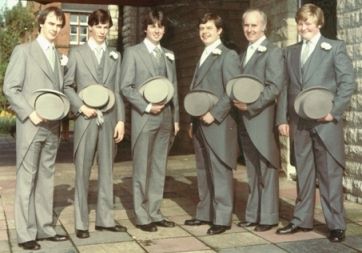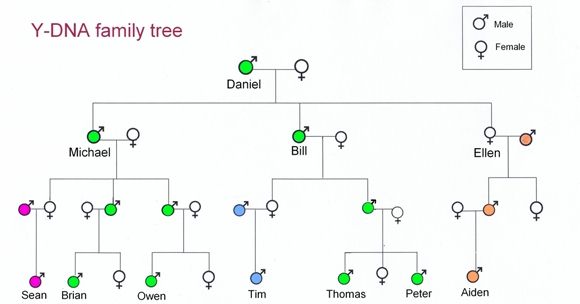- Home ›
- Genealogy and DNA testing ›
- Y-DNA for the paternal line
y-DNA: the paternity dna test
Commonly known as a paternity dna test, the y-Line or y-DNA test is gaining popularity within genealogical circles because, like
surnames, y-DNA follows the male line down the generations.
 My father (2nd from right) passed his Y-dna to his 5 sons, but not to his daughters.
My father (2nd from right) passed his Y-dna to his 5 sons, but not to his daughters. My father (2nd from right) passed his Y-dna to his 5 sons, but not to his daughters.
My father (2nd from right) passed his Y-dna to his 5 sons, but not to his daughters.What is a y-DNA test?
All men share the y-DNA of their father. It comes from the Y chromosone (which women don't have), and it's passed down the male line from father to son.
In genealogy, this male line is called the paternal line. Hence the term
'paternity dna test' for a DNA analysis of the Y Line. It is sometimes also
known as a DNA ancestry test, but this is more ambiguous as this term can be
applied to other DNA tests used by genealogists. Be sure to read 'The Myth of the Paternity DNA Test' on this page.
Be Prepared
The term 'non paternity event' is used to refer
to a variation in a DNA surname 'signature'. Such a variation indicates either
a different foundation of a specific line or the arrival of different genetic
material within it. In other words, an illegitimate birth of some sort. Be
prepared.
What does a paternity dna test actually analyse?
Tiny chemical markers on the Y chromosone create a distinctive pattern which allows the analyst to distinguish one male lineage from another. These patterns are known as haplogroups.
When the chromosones of two individual men share markers/haplogroups, they are related. The exact degree of relationship cannot be confirmed.
What is the genealogical value of a paternity dna test?
Y-DNA tests are most often used by genealogists with the
same surname. This is because y-DNA 'follows' the surname. This can be
seen in the diagram below which
charts the family tree of Daniel, whose y-dna is represented by the colour
green,
Of his seven great grandsons, only four Brian, Owen, Thomas and Peter carry his y-DNA. They would also share his surname.
In the modern world there is no certainty that second cousins Peter and Brian would know one another. But if they both joined a surname-based DNA genealogy project, they would soon discover they were related and would be able to extend their family trees.
This is where the genealogists start to get excited. If enough genealogists, each bringing their own section of family tree, get together, they can start linking up with other family trees.
Find out more about DNA Surname Projects in the Related Pages box.

The limitations of Y-dna
tests for genealogy
If Owen and Aiden carried out y-DNA tests, they wouldn't discover a connection (a DNA 'match', despite the fact they are second cousins.
One of four
Every man has one father, two grandfathers, four great grandfathers, eight great great grandfathers, and so on. His y-DNA, however, comes only from his direct male line from his father, his father's father, his father's grandfather and so on.
So, while Daniel in the diagram above is a perfectly valid great grandfather to each of his seven great grandsons, his y-DNA can be detected in only four of them.
The same would be true of an even closer familial
relationship: first cousins Sean and Brian. The analysis wouldn't indicate
that their grandfathers were brothers, despite this being such a close blood
connection, because Sean's y-DNA came from his father, who is not related to
either Michael or Daniel.
However, if you choose a different pair of first cousins Brian and Owen a paternity DNA test would show them to be related. So would a test carried out by Brian and Thomas.
This, then, is one of the huge limitations of y-DNA/paternity DNA tests. Even close blood relationships will be missed when there is no y-DNA connection.
Sean, Tim and Aiden, although still Daniel's great grandsons, share neither his y-dna nor his surname. This is because they are related to him through a female ancestor.
Women don't inherit y-DNA, and they (historically, if less so today) change their surname on marriage. From a y-DNA test perspective, they are invisible.
The limitations of Y-dna tests for genealogy
If both Owen and Aiden had y-DNA tests, they wouldn't discover a connection (a DNA 'match'), despite the fact they are second cousins.
The same would be true of an even closer familial relationship: first cousins Sean and Brian. The analysis wouldn't indicate that their grandfathers were brothers, despite this being such a close blood connection, because Sean's y-DNA came from his father, who is not related to either Michael or Daniel.
However, if you choose a different pair of first cousins Brian and Owen a paternity DNA test would show them to be related. So would a test carried out by Brian and Thomas.
One of four
Every man has one father, two grandfathers, four great grandfathers, eight great great grandfathers, and so on. His y-DNA, however, comes only from his direct male line from his father, his father's father, his father's grandfather and so on.
So, while Daniel (see diagram above) is a perfectly valid great grandfather to each of his seven great-grandsons, his y-DNA is detected in only four of them.
This, then, is one of the huge limitations of y-DNA/paternity DNA tests. Even close blood relationships will be missed when there is no y-DNA connection.
Sean, Tim and Aiden, although still Daniel's great grandsons, share neither his y-DNA nor his surname. This is because they are related to him through a female ancestor.
Women don't inherit y-DNA, and they (historically, if less so today) change their surname on marriage. From a y-DNA test perspective, they are invisible.
The myth of the paternity dna test
The term 'paternity dna test' has, until recently, been associated with
tabloid stories of women seeking to prove their new-born sons were fathered by
named celebrities. These stories demonstrate just one use of the so-called
paternity dna test, but they have also mis-informed the public about the way
such tests work.
Because these stories concentrate on salacious rather than scientific details, the public has made understandable but erroneous assumptions. They assume that such a test can prove (or disprove) that a named celebrity (let's call him Rock Star Ed), is the only possible father of a child (we'll name him Little Jimmy). This is wrong.
In such a case, a paternity dna test could:
- prove that Little Jimmy does not share Y-dna with Rock Star Ed (who cannot therefore be the father), or
- prove that the two share Y-dna (so Little Jimmy is related in some way to Rock Star Ed).
In the latter result, it is not possible to confirm the relationship between the two. The father could be Rock Star Ed; it could also be Rock Star Ed's brother, father, uncle, grandfather, cousin or any other male relative from their direct paternal line.
What usually happens in such cases is that Rock Star Ed, knowing what took place nine months ago, acknowledges the child as his offspring when a paternity dna test proves a familial link.